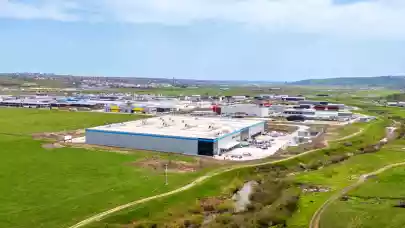
The beginning of the year was marked by the Russian invasion of Ukraine which caused various obstacles to the Slovak economy. It pushes inflation up to the highest in 17 years as also the prices of food, housing and energy. Nevertheless, the lifted lockdown measures helped boost retail sales and new office leases surpassed renegotiations for the sixth quarter in a row. Experts also saw a record quarter with substantial take-up and plunging vacancy rates, Cushman & Wakefield Slovakia presents in their new report on the Slovak economy.
The beginning of the year was marked by the Russian invasion of Ukraine which caused various obstacles to the Slovak economy. Not only did it push inflation up to double digits to 10.4% during March (ŠÚSR), the highest in 17 years, but also the prices of the three most important items for Slovak households - food, housing, and energy - rose at a double-digit rate. It is mainly because Russia is the main exporter of gas to Slovakia, and together with Ukraine they account for nearly 30% of the global wheat trade. As Russia is also the main exporter of various types of metals essential for construction, the prices of new development projects are predicted to rise. The situation is also aggravated by the shortage of skilled workers. But with the arrival of over 340,000 refugees from Ukraine, this brings a significant amount of workforce suitable for the service sector or manufacturing as well as new potential customers mostly in the retail sector. According to ŠÚSR, retail sales in Slovakia recorded 14.5% year-on-year growth in March, maintaining double-digit growth for the third month in a row. With the sanctions imposed on Russia and the outflow of companies from its territory, there are opportunities for companies to relocate to Central Europe, which would have a positive impact on the economy – lower unemployment associated with new jobs and therefore possible positive impact on GDP. According to the National Bank of Slovakia, GDP is predicted to grow in the range of 2-3% in the optimistic war scenario. This is assuming that the conflict will be resolved in the coming weeks. In a worse case, in which the war would last for a longer period, there is a risk that the growth of the Slovak economy will stop temporarily.
RETAIL
As the pandemic is slowly fading away, most of the COVID-19 restrictions were lifted. After two tough years for retail, which was hit the hardest of all sectors, the retail leasing activity partially returned and with it the surge in turnovers. By the end of March, some shopping centres even recorded an increase in footfall compared to the same pre-pandemic period. As in other sectors, the growth of construction costs and the length of delivery of construction materials in retail projects influenced the decision-making of developers on whether and when to complete them. We are seeing a slowdown in the construction of large-format shopping centres due to decreasing profitability of planned schemes and rising market saturation. On the opposite side, part of the retailers, which are dealing with new problems related to blocked goods for import from Russia, are suspending plans. The dynamic situation changes almost every week, but as an opportunity, we see the growing demand from the increased mobility of the population due to the end of the lockdown and the influx of refugees from neighbouring Ukraine. The total volume of retail space in Slovakia stands at about 1.4 million sqm, which means that there are roughly four inhabitants per square meter of retail. In the case of retail parks, we record a ratio of 10 inhabitants per square meter of area. The total volume of the planned retail area is up to 200,000 sqm with various completion dates.
The uncertainty associated with the conflict in Ukraine causes disruptions in delivery times and shortages of various materials or food commodities, resulting in an increase in their prices. Together with soaring prices of energy, total costs of retailers are rising, which threatens expansion plans and may push landlords to increase their rents. Despite all this, prime rent for shopping centres remains at €65/sqm /month, boosting the confidence of investors. In terms of prime yield, shopping centres remain at 6.00% with a stable near-term outlook. In the segment of retail parks and retail warehouse units, we are seeing stabilized prime yields at 7.00%.
OFFICE
The total stock surpassed 2 million for the first time this quarter as Omnia BC was completed in the Inner City submarket, adding 11,200 sqm of fully leased space. In addition, 4 out of 5 Bratislava districts saw a decrease in vacancy rates. Despite this, we recorded a slight increase in overall vacancy. In the first quarter, total take-up reached 42,900 sqm representing a 27% year-on-year decrease. Nevertheless, the first quarter’s figures indicate a solid net take-up share of 83% as new leases surpassed renegotiations sixth quarter in a row. Together with an 84% share of class A buildings in take-up, we can see a confirmed ongoing trend of tenants relocating to newer offices. Net absorption is positive fourth quarter in a row, reaching 7,100 sqm. Tenants are recognizing the need for professional office space planning, and therefore are increasingly seeking workplace strategy advisory services. This year will be calmer in terms of new supply as we will only see the completion of partially pre-leased Lake Side II scheduled for the next quarter.
In the shadow of uncertainty regarding the war in Ukraine associated with a large number of the world‘s biggest companies abandoning or scaling back their operations in Russia, investment activity has decelerated in all sectors, not excluding the office sector. Nevertheless, we expect leasing activity to pick up, with several transactions in progress confirming a recovery in the next quarters. Combined with the growing attractiveness of the sector and availability of capital, we expect prime yield compression in the upcoming quarter with the current value at 5.25%. Although prime headline rent at €16.50/sqm has not changed since the beginning of 2021, the pressure on landlords associated with rising energy prices and costs may translate into rental prices and therefore push prime rent upwards.
INDUSTRIAL
This quarter was remarkable for the industrial sector as net take-up reported a new record of 198,900 sqm. In addition to that, total take-up reached a five-year high of 211,500 sqm of leased space, representing a 53% year-on-year growth. This indicates a continuously growing demand for logistics and distribution, mainly due to the thriving e-commerce sector, as well as automotive, which is one of the strongest sectors in Slovakia. The total industrial stock grew by 7% year-on-year after the completion of four industrial parks with a total amount of 116,000 sqm. All of them are located in Western Slovakia, which confirms the attractiveness of this region and the opportunities it provides. The vacancy rate declined fourth quarter in a row by more than 1 pp to 5.6%, the lowest since 2020. This was driven mainly by strong take-up, which was also responsible for one of the highest net absorptions, reaching 143,100 sqm. However, we do not rule out the possibility of the vacancy rate surging higher in the near term since the majority of the stock to be delivered within the next 12 months is speculative. There are currently 21 buildings under construction, 15 of which are situated in Western Slovakia. Total leasable space under construction surpassed 408,000, representing yet another record. This confirms the ongoing desire of developers to expand as the demand in the industrial property sector keeps growing since it‘s the most liquid segment of real estate in Slovakia.
In the shadow of uncertainty regarding the war in Ukraine associated with a large number of the world‘s biggest companies abandoning or scaling back their operations in Russia, investment activity has decelerated in all sectors, not excluding the industrial sector. Due to the increasing costs of materials used in construction, the cost of new development projects is increasing and the delivery times of buildings are also being moved from 6-12 months to 12-15 months. Together with a strong pipeline associated with a continuously growing demand for logistics and distribution, mainly due to the thriving e-commerce sector, we see intense pressure on rents. Despite all this, prime rents remained stable in the first quarter at €4/sqm but we expect them to climb to 4.10 already during the next quarter with the prospect of further growth in the second half of the year. The situation in the automotive industry is still challenging and continues to be affected by external factors, such as the pandemic situation in the world, which varies from country to country, and the associated supply chain disruption. In addition to the lack of chips, there is also a lack of wire harnesses and other components manufactured in Ukraine, which leads to weekly forced shutdowns of major car manufacturers. In terms of prime yield, it remained at 5.25% from the previous quarter and should stay at the same level in the first half of the year as nothing indicates otherwise.



